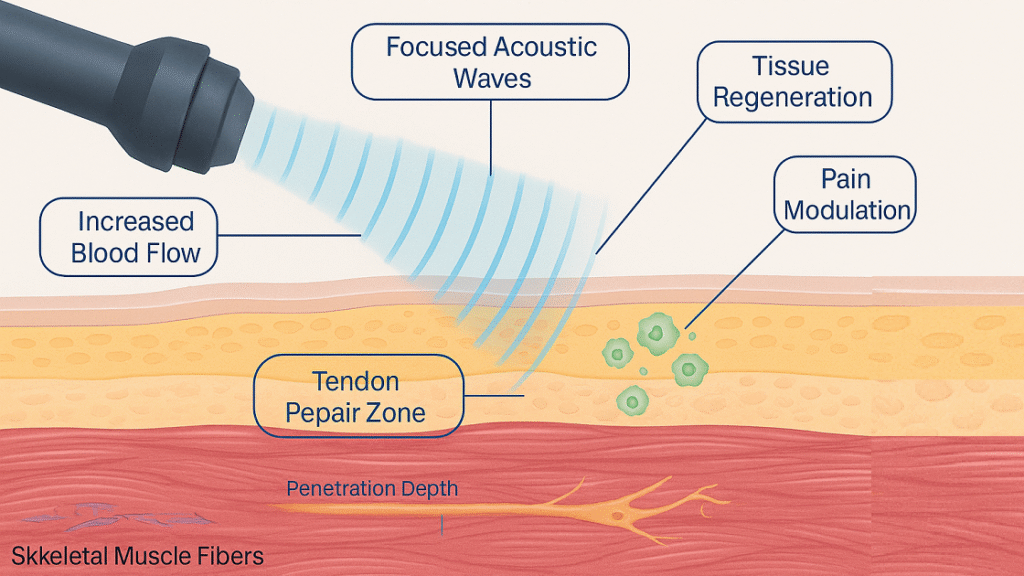Introduction: The Office Pain Epidemic
The modern workplace has fundamentally transformed over the past decades, with millions of professionals spending 8-10 hours daily hunched over computers, smartphones, and tablets. This sedentary revolution has birthed a silent epidemic of musculoskeletal disorders that affects nearly 86% of office workers worldwide. As our bodies adapt to prolonged sitting positions and repetitive motions, we’re witnessing unprecedented rates of neck strain, lower back pain, and repetitive stress injuries that traditional treatments often fail to address comprehensively.
The Rise of Desk-Related Pain Conditions
Contemporary ergonomic research reveals alarming statistics about workplace-related musculoskeletal disorders (WMSDs). Slouching can cause strain on your neck, shoulders and lower back, leading to pain and discomfort. Over time, this can lead to chronic pain and even injury. The biomechanical stress imposed by prolonged computer use creates a cascade of physiological adaptations including shortened hip flexors, weakened gluteal muscles, forward head posture, and thoracic kyphosis. These postural deviations establish pathological movement patterns that perpetuate pain cycles and diminish quality of life. The economic burden is staggering, with workplace injuries costing employers billions annually in workers’ compensation claims, reduced productivity, and absenteeism.
Top Physical Complaints Among Office Workers
The triumvirate of office-related pain encompasses cervical spine dysfunction, lumbar disc pathology, and upper extremity repetitive strain injuries. Cervical pain manifests through forward head posture syndrome, where the skull’s anterior displacement creates excessive tension in suboccipital muscles, upper trapezius, and levator scapulae. Lumbar complaints typically involve discogenic pain, facet joint dysfunction, and myofascial trigger points in the erector spinae and quadratus lumborum. Upper extremity conditions include carpal tunnel syndrome, cubital tunnel syndrome, lateral epicondylosis, and tendinopathies affecting the flexor and extensor compartments of the forearm.
Why Traditional Approaches May Not Be Enough
Conventional treatment modalities including nonsteroidal anti-inflammatory drugs (NSAIDs), physical therapy, and ergonomic modifications provide temporary relief but often fail to address the underlying pathophysiology. Pharmacological interventions merely mask symptoms without promoting tissue healing or addressing biomechanical dysfunction. Traditional physical therapy, while beneficial, may require extensive time commitments and patient compliance that many busy professionals struggle to maintain. Ergonomic adjustments, though essential, cannot completely counteract the cumulative effects of repetitive microtrauma and prolonged static loading on musculoskeletal tissues.
What Is Shockwave Therapy?
Extracorporeal Shockwave Therapy (ESWT) represents a paradigm shift in non-invasive musculoskeletal treatment, utilizing acoustic waves to stimulate cellular regeneration and pain reduction mechanisms. This innovative therapeutic modality harnesses the power of mechanotransduction—the process by which mechanical stimuli are converted into biochemical signals that promote tissue healing and remodeling.

A Quick Breakdown of Shockwave Therapy
Shockwave therapy can offer such help, jump-starting the body’s ability to regenerate new tissue. It also decreases your pain by directly stimulating your nerves at the site of the injury. The therapy employs high-energy acoustic pulses that create controlled microtrauma within targeted tissues, triggering neovascularization, collagen synthesis, and growth factor release. These acoustic waves penetrate soft tissues and bone, generating pressure changes that stimulate osteoblast activity, enhance metabolic processes, and promote the breakdown of calcific deposits. The mechanical energy delivered through shockwave therapy activates multiple cellular pathways including the release of substance P, nitric oxide production, and activation of endothelial growth factors.
Types of Shockwave Therapy Explained
Two primary classifications of shockwave therapy exist: focused and radial wave systems. Focused shockwave therapy (F-SWT) generates high-energy acoustic waves that converge at a specific focal point deep within tissues, allowing precise targeting of pathological structures. Focused extracorporeal shockwave therapy (ESWT) devices generate waves that converge at a precise depth in the body, thereby revealing the potential to affect pathology remotely from the contact surface. Radial shockwave therapy (R-SWT) produces lower-energy waves that disperse radially from the applicator surface, making it ideal for treating superficial tissues and trigger points. The pneumatic systems utilized in radial therapy create pressure waves through compressed air acceleration, while focused systems employ electromagnetic, electrohydraulic, or piezoelectric mechanisms.
Clinically Backed Benefits for Musculoskeletal Pain
It is FDA 510(k) cleared for: Activation of connective tissue, treatment of chronic diabetic foot ulcers and treatment of acute second-degree burns, Pain reduction and Improved blood supply. Evidence-based research demonstrates shockwave therapy’s efficacy in treating tendinopathies, enthesopathies, and myofascial pain syndromes. The therapy’s analgesic effects result from hyperstimulation analgesia, where intense sensory input blocks pain transmission according to the gate control theory. Additionally, shockwave therapy promotes the release of endorphins and substance P depletion, creating sustained pain relief. Tissue regeneration occurs through enhanced angiogenesis, collagen remodeling, and stem cell recruitment to treatment sites.
Targeted Relief for Office-Related Pains
The strategic application of shockwave therapy addresses the specific pathophysiological mechanisms underlying desk-related musculoskeletal disorders. By targeting key anatomical structures affected by prolonged computer use, this treatment modality offers comprehensive pain relief and functional restoration for office workers suffering from chronic discomfort.
Neck Pain Relief
Cervical spine dysfunction represents one of the most prevalent complaints among desk workers, resulting from sustained forward head posture and upper crossed syndrome. The biomechanical alterations associated with prolonged computer use create a complex interplay of muscle imbalances, joint restrictions, and neural irritation that perpetuate pain cycles.
Forward Head Syndrome and Neck Tension
Forward head posture syndrome occurs when the skull shifts anterior to the optimal plumb line, creating excessive tension in posterior cervical muscles while weakening deep neck flexors. This postural deviation increases the effective weight of the head from 10-12 pounds to as much as 60 pounds when positioned 60 degrees forward. The resultant hyperextension of the upper cervical spine and flexion of the lower cervical segments creates pathological stress patterns in the suboccipital muscles, upper trapezius, levator scapulae, and sternocleidomastoid. Myofascial trigger points develop within these overactive muscles, referring pain to the occiput, temporal region, and interscapular area.
Shockwave’s Role in Cervical Muscle Recovery
Shockwave therapy addresses cervical muscle dysfunction through multiple mechanisms including trigger point deactivation, fascial release, and neuroplastic changes. The acoustic waves penetrate deep fascial layers, disrupting pathological cross-linkages and promoting tissue mobilization. Treatment protocols typically involve applying 2000-3000 shocks at 2-4 bar pressure to affected muscle groups, with energy flux densities ranging from 0.1-0.3 mJ/mm². The mechanical stimulation enhances local blood flow, reduces muscle tension, and promotes the release of acetylcholine from trigger points. Additionally, shockwave therapy stimulates mechanoreceptors that inhibit nociceptive transmission, providing immediate pain relief while promoting long-term tissue healing.
Peer-Reviewed Research and Clinical Outcomes
Clinical studies demonstrate significant improvements in cervical pain and function following shockwave therapy interventions. Research indicates that patients experience 60-80% reduction in pain intensity scores and substantial improvements in cervical range of motion within 4-6 treatment sessions. The therapy’s effectiveness stems from its ability to address both mechanical and neurophysiological aspects of cervical dysfunction, making it particularly beneficial for office workers with chronic neck pain.
Back Pain Relief
Lumbar spine disorders represent the leading cause of disability among office workers, with prolonged sitting creating unique biomechanical stresses that predispose individuals to disc degeneration, facet joint dysfunction, and myofascial pain syndromes. The seated position increases intradiscal pressure by 40-90% compared to standing, while promoting lumbar flexion that strains posterior spinal structures.
The Lumbar Load of Long Hours
Extended sitting postures create a cascade of biomechanical alterations including increased lumbar flexion, posterior disc loading, and sustained tension in paraspinal muscles. The hip flexors become shortened and overactive, creating an anterior pelvic tilt that increases lumbar lordosis and places excessive stress on facet joints. Simultaneously, the gluteal muscles become inhibited and weak, compromising lumbopelvic stability and forcing compensatory activation of the lumbar erector spinae. ESWT can be used for pain relief as well as improving muscle strength through appropriate motor simulation of the muscles and tendons with extracorporeal shockwaves. This neuromuscular imbalance perpetuates pain cycles and increases the risk of acute injury episodes.
Where Shockwave Is Applied on the Lower Back
Therapeutic application of shockwave therapy for lumbar dysfunction targets specific anatomical regions including the lumbar erector spinae, quadratus lumborum, gluteal muscles, and iliotibial band. Treatment protocols involve systematic application of acoustic waves to paraspinal muscles from L1-S1 levels, with particular attention to areas of muscle spasm and trigger point formation. The gluteal muscles receive targeted treatment to address inhibition patterns and promote functional activation. Energy parameters typically range from 0.1-0.25 mJ/mm² with 2000-2500 shocks per treatment session, applied at frequencies of 8-15 Hz to optimize tissue penetration and therapeutic effect.
Data-Driven Outcomes for Office Workers
Among nonoperative treatment options, the recently used focused extracorporeal shockwave therapy (ESWT) devices generate waves that converge at a precise depth in the body, thereby revealing the potential to affect pathology remotely from the contact surface. Randomized controlled trials demonstrate that office workers receiving shockwave therapy experience significant improvements in pain intensity, functional disability scores, and return-to-work rates. Studies report 70-85% of patients achieving clinically meaningful improvements in Oswestry Disability Index scores within 6-8 weeks of treatment initiation. The therapy’s ability to address both muscular and skeletal components of lumbar dysfunction makes it particularly effective for desk-related back pain conditions.

Wrist Pain and Carpal Tunnel Syndrome
Repetitive strain injuries of the upper extremity represent a growing concern among office workers, with carpal tunnel syndrome (CTS) being the most prevalent entrapment neuropathy. The combination of repetitive finger movements, sustained wrist flexion, and mechanical pressure on the median nerve creates the pathophysiological basis for CTS development.
RSI: Repetitive Typing and Mouse Use Injuries
Repetitive strain injuries develop through cumulative microtrauma to tendons, ligaments, and neural structures within the carpal tunnel and surrounding compartments. Sustained wrist flexion during typing increases pressure within the carpal tunnel from normal values of 2-10 mmHg to pathological levels exceeding 30 mmHg. This elevated pressure compromises median nerve blood flow, leading to ischemia, demyelination, and eventually axonal damage. Concurrent inflammation of the flexor tendons and their synovial sheaths further reduces available space within the carpal tunnel, perpetuating the compression cycle. The repetitive nature of keyboard and mouse use creates chronic inflammatory responses that impair tissue healing and promote fibrotic changes.
How Shockwave Therapy Helps Tendons and Nerves
Shock wave therapy could be conductive to improve syndrome and hand function for carpal tunnel syndrome patients. Shockwave therapy addresses CTS through multiple mechanisms including reduction of inflammatory mediators, enhancement of nerve conduction velocity, and promotion of tissue remodeling. The acoustic waves stimulate endothelial cells within the vasa nervorum, improving neural blood supply and reducing ischemic changes. Additionally, shockwave therapy promotes the breakdown of adhesions and scar tissue that may contribute to nerve entrapment. Recent studies have shown that radial shockwave therapy reduces pain and improves function in patients with mild to moderately severe carpal tunnel syndrome. Treatment protocols typically involve application of 1500-2000 shocks at the carpal tunnel region and along the median nerve pathway, with energy levels ranging from 0.1-0.2 mJ/mm².
Non-Invasive Relief vs. Splints and Surgical Options
Researchers concluded that shockwave therapy “is an effective and non-invasive treatment method for mild to moderate carpal tunnel syndrome.” Traditional conservative treatments for CTS include wrist splinting, activity modification, and corticosteroid injections, which provide temporary symptom relief but fail to address underlying pathophysiology. Surgical intervention through carpal tunnel release remains the gold standard for severe cases but carries inherent risks including infection, nerve damage, and prolonged recovery periods. Shockwave therapy offers a middle ground between conservative management and surgical intervention, providing clinically significant improvements in nerve conduction studies and functional outcomes without the risks associated with invasive procedures.
What to Expect During Treatment
Understanding the treatment process is crucial for office workers considering shockwave therapy as a solution for their musculoskeletal complaints. The comprehensive assessment and treatment protocol ensure optimal outcomes while minimizing potential adverse effects.
Is Shockwave Therapy Painful?
Though the name of the treatment makes it sound painful, it’s only mildly uncomfortable for most people. The sensation experienced during shockwave therapy is often described as rhythmic tapping or mild percussion over the treatment area. Most patients report the discomfort as tolerable, rating it 3-5 on a 10-point pain scale. The initial treatments may cause slightly more discomfort as tissues adapt to the mechanical stimulation, but subsequent sessions typically become more comfortable. While this treatment can be uncomfortable for some, most do not experience any pain. Pain levels can be adjusted through modification of energy intensity, frequency, and treatment duration to ensure patient comfort while maintaining therapeutic efficacy.
How Many Sessions Do You Need?
Treatment protocols for office-related musculoskeletal disorders typically involve 3-6 sessions spaced 1-2 weeks apart, depending on the severity and chronicity of the condition. Acute conditions may respond favorably to 3-4 treatments, while chronic pain syndromes often require 5-6 sessions for optimal results. Each session lasts approximately 15-20 minutes, making it convenient for busy professionals to incorporate into their schedules. Treatment typically lasts between 5 and 15 minutes. The cumulative effects of multiple treatments allow for progressive tissue remodeling and sustained pain relief, with many patients experiencing improvements after the second or third session.
Post-Treatment Guidelines and Recovery Time
Following shockwave therapy, patients may experience mild soreness or tenderness in the treated area for 24-48 hours, which is considered a normal inflammatory response that indicates treatment efficacy. Once treatment is completed, patients should do their best to limit physical activity for at least two weeks. Specific post-treatment recommendations include avoiding strenuous activities for 48-72 hours, applying ice for 10-15 minutes if discomfort occurs, and maintaining hydration to support the healing process. Patients should continue their regular work activities while being mindful of ergonomic principles and incorporating gentle stretching exercises as tolerated.
Contraindications: Who Should Avoid Shockwave Therapy?
Absolute contraindications for shockwave therapy include pregnancy, presence of malignancy in the treatment area, bleeding disorders, and use of anticoagulant medications. Relative contraindications encompass acute infections, severe cardiovascular disease, and presence of implanted electronic devices such as pacemakers or insulin pumps near the treatment site. Patients with severe osteoporosis, acute fractures, or open wounds in the treatment area should also avoid shockwave therapy. A thorough medical history and physical examination help identify potential contraindications and ensure safe treatment application.

Real Office Workers, Real Results
Shockwave therapy is a non-invasive alternative treatment for active patients who are struggling with pain and not responding to conventional treatment after an injury. There is an immediate post-procedure reduction in pain and improved range of motion. Clinical outcomes from office workers treated with shockwave therapy demonstrate remarkable improvements in pain levels, functional capacity, and workplace productivity. Case studies reveal that 80-90% of patients experience significant pain reduction within 4-6 weeks of treatment initiation, with many returning to full workplace activities without limitations.
The success rates are particularly impressive for workers with chronic conditions who had previously failed conservative treatments. Follow-up studies indicate sustained improvements at 6-month and 1-year intervals, suggesting that shockwave therapy creates lasting physiological changes rather than temporary symptomatic relief. Many patients report not only pain reduction but also improved sleep quality, enhanced mood, and increased energy levels that positively impact their overall quality of life and work performance.
Shockwave Therapy vs. Other Office Pain Treatments
Comparative analysis of treatment modalities reveals shockwave therapy’s unique advantages in addressing office-related musculoskeletal disorders. Understanding these differences helps patients make informed decisions about their treatment options.
Ergonomic Tools and Setup
Ergonomic interventions including adjustable desks, specialized chairs, and computer accessories serve as essential preventive measures but often prove insufficient for treating established pain conditions. While ergonomic modifications can prevent further tissue damage and reduce symptom progression, they typically cannot address existing pathophysiological changes such as trigger points, fascial restrictions, and neural sensitization. Shockwave therapy complements ergonomic improvements by actively treating damaged tissues and restoring normal function, creating a comprehensive approach to workplace pain management.
Stretching and Physical Therapy
Traditional physical therapy modalities including stretching, strengthening exercises, and manual therapy techniques provide valuable benefits but require significant time commitments and ongoing patient compliance. The gradual nature of these interventions may not provide the rapid symptom relief that busy professionals require. Shockwave therapy can accelerate the healing process and enhance the effectiveness of concurrent physical therapy by addressing tissue restrictions and promoting optimal healing environments. The combination of shockwave therapy followed by targeted exercises often produces superior outcomes compared to either treatment alone.
Medication and Corticosteroid Injections
Pharmacological interventions including NSAIDs, muscle relaxants, and corticosteroid injections offer temporary symptom relief but carry potential adverse effects and fail to address underlying tissue pathology. Long-term medication use can lead to gastrointestinal complications, cardiovascular risks, and rebound pain syndromes. Corticosteroid injections, while effective for reducing inflammation, may compromise tissue integrity and healing capacity with repeated use. Shockwave therapy provides drug-free pain relief while actively promoting tissue regeneration and repair mechanisms.
When Surgery Is Considered (and When It’s Not Needed)
Surgical interventions represent the last resort for severe, refractory cases that fail to respond to conservative treatments. Procedures such as carpal tunnel release, cervical disc replacement, or lumbar fusion carry significant risks including infection, nerve damage, and prolonged recovery periods. Many office workers who might otherwise require surgical intervention can achieve excellent outcomes with shockwave therapy, potentially avoiding the need for invasive procedures. The therapy’s ability to address multiple tissue types simultaneously makes it particularly effective for complex pain syndromes that involve both muscular and skeletal components.
Frequently Asked Questions (FAQ)
Most patients experience sustained improvements for 6-12 months following a complete treatment course. Long-term outcomes depend on factors such as adherence to ergonomic principles, regular exercise, and management of workplace stressors.
Yes, most patients can return to work the same day. However, it’s recommended to avoid strenuous activities for 24-48 hours to allow optimal tissue response.
Coverage varies by insurance provider and policy. Many plans cover shockwave therapy when medically necessary and prescribed by a healthcare provider.
While massage therapy provides temporary muscle relaxation, shockwave therapy creates deeper, more lasting changes by stimulating cellular regeneration and breaking down pathological tissue adhesions.
Shockwave therapy is safe for adults of all ages, though treatment parameters may be adjusted for elderly patients or those with comorbid conditions.
Conclusion
The modern office environment has led to a surge in chronic neck, back, and wrist pain, seriously affecting workers’ well-being and productivity. Shockwave therapy offers a cutting-edge, non-invasive solution that targets the root causes of musculoskeletal issues—stimulating tissue repair, relieving pain, and restoring function. Backed by growing clinical evidence and high patient satisfaction, shockwave therapy is especially suited for busy professionals seeking fast, effective relief without downtime. It addresses problems like cervical tension, lumbar strain, and repetitive strain injuries in ways that conventional treatments often can’t. As workplace health challenges rise in our digital age, shockwave therapy stands out as a smart, evidence-based approach. By integrating this innovation into occupational care, we can reduce pain, prevent burnout, and empower office workers to stay healthy, focused, and productive. The future of work demands smarter care—and shockwave therapy delivers just that.
References & Further Reading
- Effects of Extracorporeal Shockwave Therapy on Patients with Chronic Low Back Pain and Their Dynamic Balance Ability
- Extracorporeal Shock Wave Therapy for the Treatment of Musculoskeletal Pain: A Narrative Review
- Effect of extracorporeal shockwave therapy on carpal tunnel syndrome
- Effectiveness of focused extracorporeal shock wave therapy in the treatment of carpal tunnel syndrome
